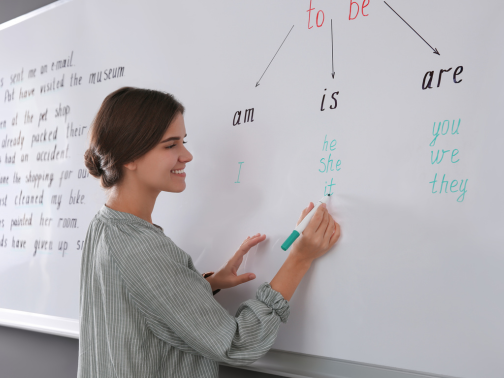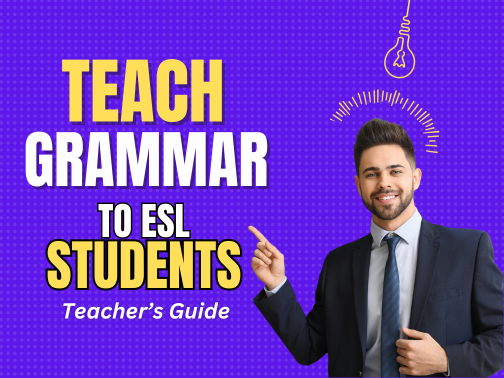Contents
Toggle
Meet David De’ Ath, founder, editor, and writer at Wonderful World English. With his extensive background as an English teacher, David provides valuable insights and practical tips on ESL for students and teachers alike.
English as a Second Language (ESL) is in growing supply worldwide.
From young learners to adults and business to academia, there is a constant demand for non-native speakers to study English.
With this comes some challenges for both teachers and students involved, especially when covering areas of English that are distinctively different from the native language of the student.
ESL students find English grammar difficult due to the variety of complex rules and general differences from their native language.
To teach grammar to ESL students, a teacher should start with the basics. By using clear explanations, providing examples, and allowing their students to engage in activities and practice speaking, students will begin to understand how to produce English grammar correctly.
I have been teaching ESL for several years and have seen firsthand non-natives’ struggles when learning English.
Grammar is a fundamental aspect of English and being able to teach it effectively make the learning process much better for both students and teachers.
In this guide, we will discuss the basics of English grammar and some great techniques to help students (both young and mature) learn it more effectively.
Let’s jump in!
How to Teach Grammar to ESL Students – Understanding Grammar
Before we dive into any teaching techniques, it’s essential to understand the basics of grammar.
ESL students need a solid foundation in grammar to develop their language skills.
Here are some key concepts of English grammar:
1. Parts of Speech
One fundamental aspect of English grammar is the eight different parts of speech.
Knowing these different parts is important for students to produce English sentences properly.
This means learning the difference between nouns, verbs, adjectives, adverbs, and so on…
It can be very difficult for ESL learners to grasp because of the difference between English grammar as it is different from that of many other languages.
The eight different parts of speech include:
Butte.edu
- Noun – A noun is the name of a person, place, thing, or idea. (e.g., man, dog, Alabama…)
- Pronoun – A pronoun is a word used in place of a noun. (e.g., she, they, it…)
- Verb – A verb expresses action or being. (e.g. kick, play, write…)
- Adjective – An adjective modifies or describes a noun or pronoun. (e.g. young, beautiful, funny…)
- Adverb – An adverb modifies or describes a verb, an adjective, or another adverb. (e.g. quickly, carefully, well…)
- Preposition – A preposition is a word placed before a noun or pronoun to form a phrase modifying another word in the sentence. (e.g. with, about, until…)
- Conjunction – A conjunction joins words, phrases, or clauses. (e.g. because, and, or…)
- Interjection – An interjection is a word used to express emotion. (e.g. wow, oh, oops…)

2. Tenses
Another important aspect of English grammar is the present, past, and future tenses.
In some languages, such as Mandarin, the way people describe when something happens is very different from English.
For example, an English-speaking person would say, “Have you eaten yet?” whereas a Mandarin speaker would say, “你吃了吗” (Nǐ chī le ma).
This is a common greeting in China, and in this sentence, the 了 (le) character causes the sentence to become past tense.
In English, of course, there is no set word to cause a sentence to become past tense, but words will change to fit the context.
Sit becomes sat, eat becomes ate, find becomes found, etc.
This aspect of English grammar is very difficult for ESL learners with languages that don’t have a similar system to grasp.
And between English and Mandarin, Mandarin’s tense system is much simpler.
But that doesn’t make learning everything else about it so!
If you’re interested in finding out more about learning Mandarin as an English speaker, check out the great article below from someone who has been there and done it!
Related Article: Is Mandarin Hard to Learn for English Speakers? – The Truth

3. Subject-Verb Agreement
A grammatical rule that every English learner will need to understand is that of subject-verb agreement.
This rule states that the sentence’s subject must agree with the verb regarding number and person.
In other words, singular subjects require singular verbs, and plural subjects require plural verbs.
Subject-verb agreement is the grammatical rule that the verb or verbs in a sentence must match the number, person, and gender of the subject; in English, the verb needs to match just the number and sometimes the person.
Grammarly.com
Check out some examples of subject-verb agreement in the table below:
Scribbr.com
Be The result is significant. The results are significant. Do The student does her best. The students do their best. Become The child becomes happier. The children become happier. Cause That tree causes hay fever. Those trees cause hay fever. Analyze The author analyzes the text. The authors analyze the text. Subject-Verb Agreement | Examples
Subject-verb agreement may come naturally to native English speakers, but it can be tricky for ESL students!

4. Word Order
Last but not least, understanding the word order of a sentence is very important for ESL learners to communicate in English effectively.
As an ESL teacher in China, it is not uncommon for one of my students to say something like “A red big ball” instead of “a big red ball”.
This is because their native language does not adhere to English’s word order.
The standard order of words in an English sentence is subject + verb + object. While this sounds simple, it may be difficult to identify the subject(s), verb(s), and object(s), depending on the structure and complexity of the sentence.
Wordvice.com
This aspect of English can be challenging for ESL students, so they should learn the typical subject-verb-object order and exceptions to this rule.
With patience, practice, and perseverance, you can help your students understand these grammatical rules and bring their English-speaking ability to the next level.

Techniques for Teaching Grammar
As we can see from the basics of grammar, there is much to cover!
Teaching grammar can be tedious and overwhelming for both teachers and students.
But it doesn’t have to be!
Here are some effective techniques for teaching grammar to ESL students:
1. Explicit Instruction
Explicit instruction involves directly teaching grammar rules through lectures, exercises, and worksheets.
This technique is especially useful for introducing new grammar concepts.
Explicit instruction is a series of instructional behaviors that increase the likelihood for student achievement. Think of it as improving student outcomes with elevating your practice. The behaviors that we will look at are all about providing students with frequent opportunities to respond.
Vanderbilt.edu
By giving ESL students plenty of opportunity to engage, practice, and interact, all while speaking clearly and directly – they will be sure to make progress!
As you can see, this guide is mostly orientated around face-to-face learning.
But what about online learning?
If you’ve ever wondered which of these two forms of learning is best, you should check the article below to find out!
Related Article: Is Online Learning as Good as Face-to-Face Learning?

2. Contextual Learning
Contextual learning involves teaching grammar in a context the student can easily understand.
Almost all researchers agree that grammar should not be taught explicitly.
They argue that grammar should be used in a meaningful context, such as in real-life situations.
For example, working through a reading passage or watching a video of a conversation between two people in an everyday setting will help build comprehension and the student’s grammatical understanding.
Use authentic films, books, articles, and songs. By doing that, we are presenting grammar as a part of language and communication, not just as a tedious thing that has to be learned for the test.
Teachingenglish.org.uk
Applying contextual learning will help ESL students understand how English grammar is used in real-world situations.
For a complete guide on understanding English grammar that is perfect for both students and teachers, check out the link below!
Related: Easy Grammar Tricks: Ultimate Guide for Students

3. Interactive Games and Activities
Including games and activities can take the learning experience to a whole new level for your students.
There are many great examples of fun activities an ESL teacher can perform with their students.
Using grammar-based board games, doing quizzes, and playing grammar bingo are all great examples of activities that you can include to keep your lessons fun and engaging.
The goal is to reach a point where students can produce grammar without consciously thinking about it – and focusing attention on a game while requiring use of the target language is a great way to do this.
Eslactive.com
This technique is especially effective for kinesthetic learners who like to get more hands-on while they study.
Check out this list of 18 ESL grammar activities you can include in your lesson plans from teachingexpertise.com! – Click here

4. Peer Learning
Peer learning is an approach that involves students working together to learn and practice grammar.
This can be in pairs or groups; each team can be assigned a task and work together while giving each other feedback.
Essentially it is the idea that the teacher facilitates the beginning of a lesson but encourages a great deal of peer-to-peer correction (with the guidance and supervision from the teacher), strategizing communication, and teamwork among students.
Ontesol.com
By promoting peer learning, an ESL teacher will help build a supportive learning environment where students can actively participate in their language development.

Strategies for Engaging ESL Students
Teaching grammar to ESL students can be tough if not done efficiently.
We’ve all experienced it at some point on our teaching ESL journeys, a class of bored and disengaged students who shudder at the word grammar.
Well, maybe it’s not quite dramatic, but keeping students engaged is still a skill in and of itself!
Here are some useful strategies for engaging ESL students:
1. Use Visual Aids
As an ESL teacher, I can attest to the benefits of using visual aids.
They are an excellent resource for teaching English as they enhance comprehension, engagement, and retention of information.
Visual aids can come in the form of flashcards, posters, pictures, PPTs, videos, graphs, physical objects, and anything visually stimulating and relevant to the lesson.
Here are three great visual aid ideas for teaching grammar to ESL students:
– Posters
Creating colorful and visually stimulating posters that display grammatical rules and provide examples can be a great way to help students improve their grammar.
This doesn’t have to be limited to posters either; there are many ways to get creative and make learning grammar more enjoyable.
Comics and leaflets can also be great activities to include in a lesson.
Getting creative is a sure way to keep students engaged, switched on, and able to retain more information.

– Word Cards
Incorporating word cards is another fun and effective way to keep ESL students engaged.
These are sets of cards with different words coded with different colors or symbols to show whether they are nouns, verbs, adjectives, etc.
Making word cards can be a lot of fun for students in the classroom and gives them something to take away to practice their grammar at home.
Using word cards makes it easier for students to identify and use words properly in a sentence.

– Diagrams
Visual diagrams are another great way to bolster ESL students’ grammar comprehension.
These illustrate the structure of sentences and help students understand the role of words or phrases in a sentence.
This may not be as effective for younger learners, but it will still help boost comprehension in ESL learners if explained properly by a dedicated teacher.

2. Incorporate Technology
In the modern age, a wealth of resources are available to help teachers effectively teach grammar.
By including online games, interactive whiteboards, and language learning apps, students will have many opportunities to engage in language learning activities, ultimately improving their grammar.
My students love it when we play a game on an interactive whiteboard, but it’s important not to always focus entire lessons around this.
I suggest mixing technology with activities for the best results.
Click the link below for a list of the best English grammar apps!
Related Article: Which is the Best App for Learning English Grammar? – Top 10

3. Personalize Lessons
Building lessons that are more personalized and relatable to your student’s culture can help them build links between the English language and their everyday lives.
For example, when teaching my Chinese students, I will include vocabulary and references that they can easily relate to.
Familiar foods, places, and stories are all great ways to personalize lessons, which will aid in general comprehension.
China is just one of many countries in Asia that put a lot of emphasis on learning English.
If you’re curious about the relationship between English and other Asian countries, check out the guide below!
Related Article: What Asian Countries Speak English? – Full Guide
4. Encourage Participation
Another important strategy to implement when teaching ESL is always to encourage participation.
There will always be a disparity between those who are confident and those who are too shy to speak.
It’s up to the teacher to recognize these students and get them involved as much as they can.
This will boost general confidence, ultimately aiding their English development.
I’ve had it plenty of times when I see a student keeping their head down, trying hard not to be seen.
It can feel a little cruel to ask them to answer a question or participate in an activity, but it will benefit them in the long run.
There’s no need to push a student too hard, but it’s important for a good ESL teacher to notice which students require some extra encouragement and to do so in a warm manner.
This is just one of many strategies a good ESL teacher can implement.
Check out the article below to discover exactly what else it takes to be a good ESL teacher!
Related Article: How to Be a Good ESL Teacher – Teacher’s Guide

Conclusion
In conclusion, teaching grammar to ESL students comes with many potential difficulties.
This is mostly due to the many differences between English grammar and that of their native language.
This means teaching grammar effectively requires a unique approach.
It’s first important to understand the basics of grammar and how it is relevant to everyday life.
Visual aids, technological resources, and personalized lessons are all very important in conducting an effective grammar session for ESL students.
Always encourage students to get involved, which will enhance their learning experience and the rate at which they begin to understand what is being taught.
With the right strategies and techniques, teaching grammar to ESL students can be done effectively and be a rewarding experience for both students and teachers.
We hope this helps you better understand teaching grammar to ESL students and how you can do it more effectively.
Image Attribution: All images licensed via canva.com





